With my metaverse evangelist hat on I have for many years, in presentations and conversations, tried to help people understand the value of using game style technology in a virtual environment. The reasons have not changed, they have grown, but a basic use case is one of being able to experience something, to know where something is or how to get to it before you actually have too. The following is not to show off any 3d modelling expertise, I am a programmer who can use most of the tool sets. I put this “place” together mainly to figure out Blender to help the predlets build in things other than minecraft.With new windows laptop, complementing the MBP, I thought I would document this use case by example.
Part 1 – Verbal Directions
Imagine you have to find something, in this case a statue of a monkey’s head. It is in a nice apartment. The lounge area has a couple of sofas leading to a work of art in the next room. Take a right from there and a large number of columns lead to an ante room containing the artefact.
What I have done there is describe a path to something. It is a reasonable description, and it is quite a simple navigation task..
Now lets move from words, or verbal description of placement to a map view. This is the common one we have had for years. Top down.
Part 2 – The Map
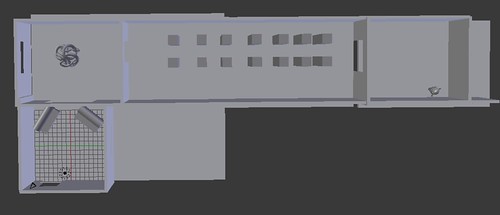
A typical map, you will start from the bottom left. It is pretty obvious where to go, 2 rooms up and turn right and keep going and you are there. This augments the verbal description, or can work just on its own. Simple, and quite effective but filters a lot of the world out in simplification. Mainly because maps are easy to draw. it requires a cognitive leap to translate to the actual place.
Part 3 – Photos
You may have often seen pictures of places to give you a feel for them. They work too. People can relate to the visuals, but it is a case of you get what you are given.
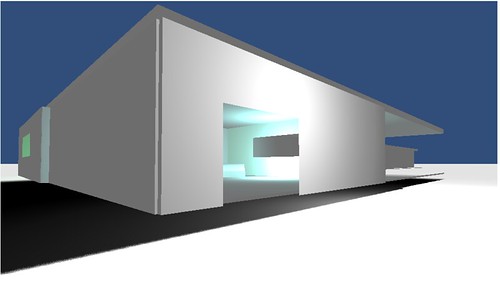
The entrance
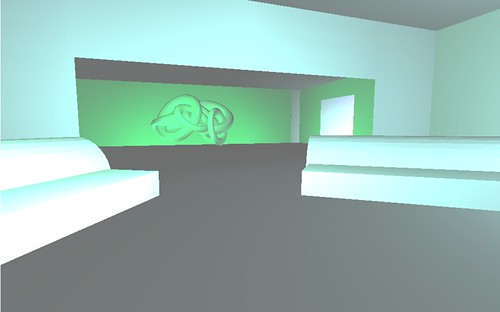
The lounge
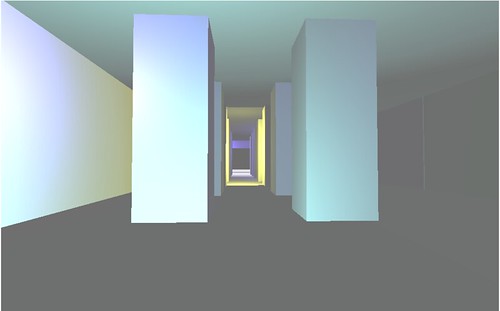
The columned corridor
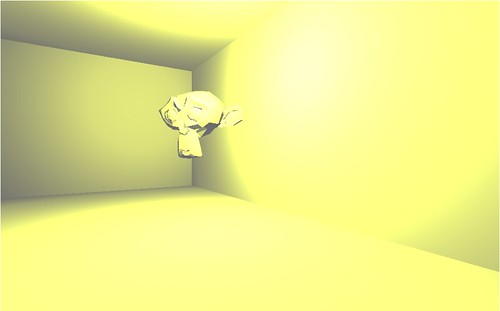
The goal.
Again in a short example this allows us to get quite a lot of place information into the description. “A picture paints a thousand words”. It is still passive.
A video of a walkthrough would of course be an extra step here, that is more pictures one after the other. Again though it is directed.You have no choice how to learn, how to take in the place.
Part 4 – The virtual
Models can very easily now be put into tools like Unity3d and published to the web to be able to be walked around. If you click here, you should get a unity3d page and after a quick download (assuming you have the plugin 😉 if not get it !) you will be placed at the entrance to the model, which is really a 3d sketch not a full on high end photo realistic rendering. You may need to click to give it focus before walking around. It is not a shared networked place, it is not really a metaverse, but it has become easier than ever to network such models and places if sharing is an important part of the use case (such as in the hospital incident simulator I have been working on)
The mouse will look around, and ‘w’ will walk you the way you are facing (s is backwards a,d side to side). Take a stroll in and out down to the monkey and back.
I suggest that now you have a much better sense of the place, the size, the space, the odd lighting. The columns are close together you may have bumped into a few things. You may linger on the work of art. All of this tiny differences are putting this place into you memory. Of course finding this monkey is not the most important task you will have today, but apply the principle to anything you have to remember, conceptual or physical. Choosing your way through such a model or concept is simple but much more effective isn’t it? You will remember it longer and maybe discover something else on the way. It is not directed by anyone, your speed your choice. This allows self reflection in the learning process which re-enforces understanding of the place
Now imagine this model, made properly, nice textures and lighting, a photo realistic place and pop on a VR headset like the Oculus Rift. Which in this case is very simple with Unity3d. You sense on being there is even further enhanced and only takes a few minutes.
It is an obvious technology isn’t it? A virtual place to rehearse and explore.
Of course you may have spotted that this virtual place whilst in unity3d to walk around provided the output for the map and for the photo navigation. Once you have a virtual place you can still do things the old way if that works for you. Its a Virtual virtuous circle!
metaverse
Oculus Rift arrived
Yesterday was a very interesting day all around. The main event for me was the arrival of my Oculus Rift development kit. This is a Virtual Reality (VR) headset. We have had these before but not ones that are this cheap (relatively) and that just plug into any machine and work with Unity3d !
It came in a cool case too. Some nice big clicking catches on it like something James Bond would get from Q.
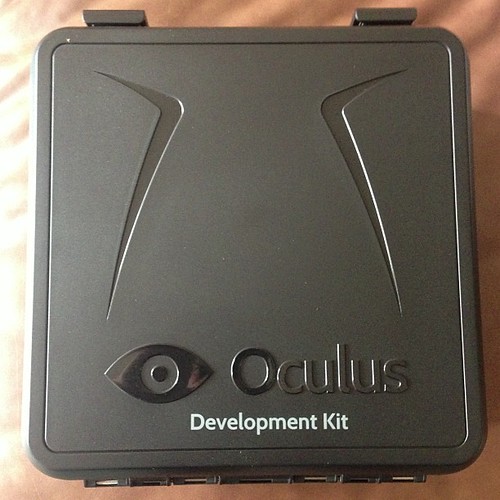
I had to dash out and get a mini display port to DVI adapter as I had that frustrating moment we have all had at some time when you realize a tiny piece of cable is missing. I only had a VGA adapter that I usually need to projectors at presentation. Handily there is a Mac store in Basingstoke and also Apple kit stocked in the nearby PC world so I had that covered in minutes.
I ran the Tuscany demo straight away. This is a small, but lovely rendered, building in the Italian countryside and on the coast. I was, despite having experienced this sort of stuff alot before suitably amazed and excited by it.
I did not hog it though and got each member of 3 generations in the house to have a go.
I was really happy that the predlets got how cool it was too. There was a suitable amount of bemusement and wonder.
The unit is two screens one for each eye and the ability to track head movements. So these head movements can then inform a game or application that you have moved you view.
The unity 3d integration is the library that is able to talk to the rift, but it is also a couple of prefabs (bundles of reusable code) that lets you change the normal single view camera to one that generates 2 views from slightly different angles to then feed to the rift screens (one per eye). Elegant and simple. It also has a controller prefab that takes the input from the headset movement and feeds that into the unity environment.
So it is not going to take to much to test some of the applications I have and make them rift enabled, though they have to be native application publications not web ones I am assuming.
It was not the only tech of the day though as in the morning Predlet 1.0 went and experienced indoor skydiving at Airkix.
Something I remember well from the TV show 🙂
She had a blast doing that.
I had a go on the iracing sim rig there had there too, this is basically a high end pc with a hydraulic chair and some force feedback steering.
We have yet to try the brush boarding or the skiplex slope (a skiing conveyer belt).
Just to juxta pose those though predlet 1.0 finished her Revell glue together and paint kit of the Titanic. Don’t worry though, it was all perfectly normal as predlet 2.0 was completing levels on Lego Indiana Jones 2 on the Xbox 🙂
InfoQ – virtual worlds interview – me again :)
As I was on the roster as the rather excellent Goto conference I was asked by Ben Linders a few questions on virtual environments and where they fit in the world of software engineering. This turned into a slightly longer interview and has just gone live. It is always interesting to frame the answers about virtual worlds into a slightly different context or industry but of course when it comes to the software industry, the fact that this is software anyway has a nice meta element to the conversation.
The article is live here.
Along with my super g33k bio picture 🙂

It is also cool that you can now just search “epredator” on infoq and tadah! 🙂
I guess this may seem more of me going on about the same things, but there is a reason for that. These technologies make a huge difference to a lot of use cases. I am getting more calls and questions again about how these may work (post bubble). Ignoring the possibilities for anyone or any industry could be costly this time around. I just want to help 🙂
Not just handbrake turns – GTA V
The original Grand Theft Auto was a great game. A top down scroller with cars that had very pleasing handbrake slides as you zoomed around the city in a sort of glorified PacMan variant. That sells it a bit short but as the creators called it that once I think I can :).
There is a complete history here on Games Radar.

I loved the top down scrolling car action not least because I had written a few demos along that sort line.Not least the cars game that was part of the developer kit with the old firms “BIG” proof of concept for in game micro transactions back in 2004 (yes they should have stuck with it but what can you do !)
So when the 3d versions of GTA started to produce more variety, but definitely keep that level of fancy driving it was fantastic.
I always have marvelled at the size of the free roaming worlds in many of the games. They just get bigger and bigger. They are not random either they are designed, intricately designed! The entire metaverse now though becomes a backdrop for narrative, not just sliding around. The good thing is though, you can ignore the story and just have some fun razzing around in cars listening to music.
If you are not a gamer and you have not watched this new video of Grand Theft Auto V the fifth installment and the latest and greatest I urge you to give it a look. Just to get a feel for the scale of these games. I am sure GTA V will not disappoint, they have just got better and better, more and more varied. They are a fantastic achievement in games and technology too.
Goto; Amsterdam part 2 of 2 –Some Choi then Makers gather
Day 2 (part 1 is here) of Goto started very early in the morning for me. I woke up and thought, hmmm I should do my Choi Kwang Do stretches and patterns, not realizing it was only 5am. Still it made me feel pretty good after the slightly heavy night out previously. Conferences are weird time shifts too, the intensity of being in conference mode needs something to balance it and this did. Besides I was going to be talking about Choi in my presentation and I had not been to class since the Saturday. It was now Wednesday!

So I entered the morning keynote pretty refreshed and ready to hear some interesting things.
The twitter wall was up and running again, as were my tweets. The wifi was rock solid the whole conference too !

First up was Martin Fowler, author of many books I have owned and read on patterns, UML etc. He had picked a couple of his talks that he has in his kit bag. For pure software engineers these were probably very useful. Schema’s still being there when there is no Schema made sense as at some point anything needs a structure put on it.
The tracks for the day were, It’s all about the people, stupid, Agile Closing the Loop, Hard Things Made Easy, Mobile, Case Studies, Legacy Systems and our Emerging interfaces track.
I stuck with the It’s all about the people, so that I could hear Linda Rising (@risinglinda) talk again. She talked about the power of the agile mindset. This was nothing about the Agile development approach, but really about human motivations and how they get messed up depending how they are addressed. Linda cited an experiment that gave an easy test to a group of students. After the test the group was divided into to by a subtle difference. This was not revealed until the rest of the story had been told. Instead Linda introduced Fixed and Agile thinking groups. Fixed being of an attitude that any task, intelligence, talent etc cannot be improved, you stick with what you have got and make the most of it, versus an agile mindset that is not fixed but is intrigued and motivated by the challenge and the effort aiming to improve.
In the story the fixed group were asked if they wanted to take a new easy test or a new hard test. They all chose easy again. The effort/agile group chose harder tests, thriving on the challenge.
There were several elements to the research that had been done that Linda recited, but it showed that the fixed mindset tends to measure itself against others being worse, assuming it can’t improve it maximises others flaws. The agile mindset looked for challenges, understood that failure was a learning experience and enjoyed the entire process comparing only to themselves and wanting to coach others to join them.
Now it turns out the only difference in the groups in the experiment was that the fixed group were handed their results and told that they were very clever. The agile group was handed the results and told they must have worked very hard. There are lots of examples of this but also that the fixed thinking tends to be destructive. The “rank and yank” approach of Enron and other corporates that seek to measure and find “the best” cut the others out etc. which leads to a set of people only wanting to not be in the bottom of the pool. This was compared to organisations like Southwest Airlines who seek to grow people, help them get better at whatever they do.
This is all out there in research, that is obviously ignored as it is a bit scary. However, linking back to my morning Choi exercises, in CKD there is no competition.We all want to learn, we want to grow and improve ourselves and help others. Nothing is ever wrong, it is a way to learn to do it better. Instructors are helped to understand how ti give positive re-enforcement and to praise effort. I don’t often hear “you are brilliant” used about people in the art, instead “that was a great effort”. Find you limit and push a little past it, then a little more. Just strive to get better not be the best. it is so simple and effective and it works.
(It has got me pondering an evolution of my blended learning piece of the pitch that features CKD and dive more into the similarity with how to do any good team growth and nurturing based on the CKD experience.)
The next presenter was Simon Brown on Sustainable competence – the people vs process and technology. This was more of a consulting experience presentation, but about the same subject. How and where it works to let people take an agile approach. It also was important to point out that Agile as a buzzword did not mean quick nor sort it out without the complications of design, build and test. In fact the examples were all of how teams that trust one another and are self organised take time. It is something that needs to be trusted to get on with itself. I had flashbacks to previous teams and how we tried to do that (without the Agile word). Always a corporate control freak would try and crush it at the wrong time.
A spot of lunch and then it was me. 50 minutes of cool stuff collective, games tech, 3d printing etc. It is my same slide deck, in a slightly different order but it is here and if you were there it might make sense 🙂 I felt the crowd were engaged and enjoying it. There were some interesting shows of hands, or not to some of my questions to see who did what where. 80% of people knew about 3d printing but the viral nature of reprap was a surprise to many.
I was really glad that all of us presenting had some freaky and interesting things to say but in particular next up after I had shown some custard pies being thrown (usually quite hard to follow) Daniel Hirschman @danielhirschman had more than enough to follow that madness. He has several angles to his work. As an artist and physical designer he has a different perspective to developers. However he also wants the world to learn to code, to be a maker to hack. This is a very cool combination. He is a fan of the Arduino and of processing, and builds real things with it.
This was fantastic, all built with arduino and some other hacks to make a corner shop a musical instrument for a beer advert by his company Hirsch and Mann ltd. Check out the other work, like the Turin interactives at the science museum.
However he also showed lots of the work too of his educational company Technology Will Save Us that makes kits with arduino and alike to let kids or any makers play with an idea and build some interesting things. His final mad example was Bright Eyes. Which he got a kickstarter going for and raised some funds
(We speculated that Andy Piper would have been one of the backers, and yes he is :))
These came out later at the party. They were very popular.
We then changed tack to several lightning 10 minute talks. We had kinect for shop windows being demoed, Dan (@mintsource) showed a clever web sockets sort of local network distributed pub quiz with real prizes. I missed out by 1 point on a prize grrr. Dan also showed Leap motion working.
I did a quick piece on Unity3d and hospitals it was great to be able to talk a bit about code and how it worked. For my own brain it was good but also to not just be the crazy virtual world guy 🙂
It was a maker fest really 🙂 It all seemed to fly by and lots of people wanted to talk afterwards to it seemed to hit the nail on the head.
I had not mentioned this conference had lots of breaks, good 30 minute ones. Not a quick 10 minutes to dash to the next talk, but ones to stop, chat, reflect etc. It’s pacing was really good. They have been doing it a while though.
The final keynote was different in that we all stood up. The chairs had gone. The speaker was Mike Lee @bmf He was talking about the App universe after the big bang. It was a war story presentation, and he admitted to being a bit jet lagged after the alternative WWDC conference he had run. He is ” Mayor of Appsterdam” and brought a typical ebullient American delivery but blende with a love of the art and culture in Amsterdam. His main thing was “don’t make games” basically he was saying it is not going to make you rich and it is too hard. He is making games, he is suffering for his art. He managed to get his plug in at the end, but as it is an educational game, or at least one that tries to blend learning and fun it is worth a look. It was entertaining and depressing in equal measure, but finished with the line “lets go drink beer”.
We all stayed at the venue for a while as it was meet the speakers time, and as a speaker I was there to be met 🙂
Then it drifted back to what must have become a very expensive bar bill at the hotel.
As mentioned the Brighteyes came out, but the also went head ot head with a Google Glass rig (and won)

It was also very cool that the father of OTI and VisualAgeSmalltalk and Java Dave Thomas also took to them 🙂
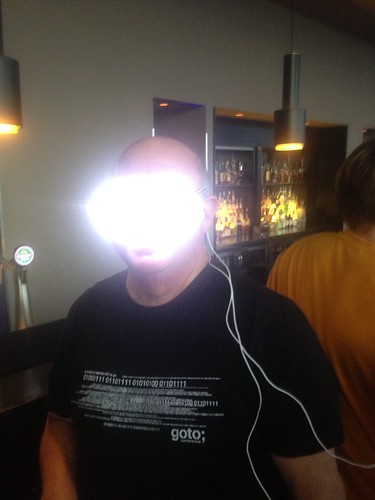
Anyway I had some awesome chats with people, made some great contacts, enjoyed what I heard and had a great trip.
So thankyou again Gotocon and trifork
Rez Day again – Reflection on 7 years of joy and pain
All the joys of trying to move physical home and my focus on training in Choi Kwang Do, plus the Predlets being on holiday meant my Rez Day in Second Life nearly passed me by! It has been just over 7 years now since diving into SL and that has been a catalyst for a great number of changes and opportunities (and quote a few threats) in my life and the lives of many of my friends and colleagues.
I am still amazed at the power of what happened back in 2006 the power of people to gather and share in a virtual space. The creativity and buzz is something that many of us will never fully experience again.
This may seem crazy but this formed part of a customer briefing on security!

We really didn’t know the potential(which is still there), we just knew that exploring code and shapes, interactions with people etc was going to take us somewhere. I mean what do you do when your scripted space hopper rolls away into someone else space?
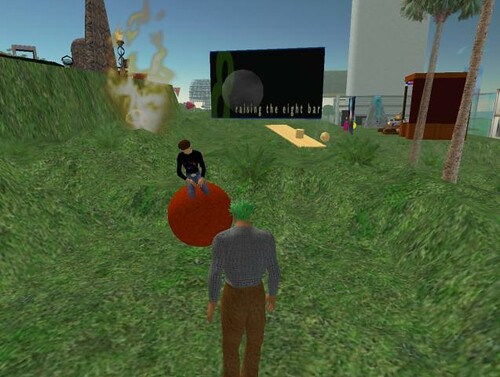
There are not many pieces of software that you can look back on and say that of. Of course the software, the networks etc was just an enabler for people to communicate and explore.
I have a collection photos of real events that happened in world. These are as memorable to me as any other photo or holiday snap. Real people doing real things, just mediated through bits and bytes.
I am still amazed though at the fear and negative vibes that many of us endured, and in some cases still do from the actions we took online with one another. It is hard to see why, when something is actually so positive it needs people to act against it. Not act against Second Life but against the freeform organisation of others. I doubt anyone who as experienced this will ever be able to fully share the full details of their particular lows. Many are deeply personal. Those acting to destroy such a positive wave of energy know full well what they were doing, who knows they may think they have won some fairground prize. In reality they have lost something and probably strengthened something and in a way done us all a favour.
What do we take as a positive from that though? Well anything that generates that much passion, both for and against it is not just another fad, another niche. It is obviously tqping into some deep needs in humans to either communicate and share, to gather together, or on the other side of the virtual coin to control and break things that they do not understand.
Unfortunately as it was the people not the software that was the problem, it was the people’s potential that got attacked not the bits and bytes.
2006-2009 was a technology bubble for virtual worlds, it was also a cultural bubble. We had to go through that and experience the joy and pain of it all in order to be here for the next wave. Culture takes a while to change but we are seeing much more sharing, much more open source. A realisation the power is in people not organisational structures. You can have a balance. You can have rank, a meritocracy. You can have rules but yet creative freedom within them.
What happened for a small portion of us in Virtual Worlds back then called eightbar was that we all worked to improve our own understanding of what the potential was, but in doing that we wanted to help others who were on the same journey. It was not about money or power. It was not about glory or control. That is hard for many people to understand who were not feeling the buzz.
I am now able to reflect on what we did instinctively for the good of the art so to speak but seeing how the martial art I study works. This does not feel a tenuous link as the conversations we have resonate with 7 years ago for me.
A martial art is a meritocracy. Through your personal goals and willingness to better yourself at your own level your earn belts. In Choi Kwang Do this is not through beating people or competing. It is not through negative comments of how badly you are doing, how much you missed a target. Instead it is active encouragement to enjoy mistakes to evolve and reach a goal. Lining up in belt rank order is never to say those with the higher belt are better. They are more experienced but they still learn, they still add to their skills. This is where it may lose some people though. We have control. A person, usually with lots of experience, will run a session. They will give commands, set tasks. We do them. It may seem regimented, yet each person is aiming to improve their technique, to learn and evolve. The person in charge at the time is also improving their own knowledge through observation, helping others with positive pointers. People step up to lead and are allowed to lead because they have earned the respect of everyone. However they never, ever apply any ego to that.
If I was to head back to 2006 and the wave of awesome virtual world discoveries, the teamwork and the sense of adventure we all had I am pretty sure I would do it all again. For me now, having seen another very positive gathering of humans trying to explore something exciting, yet applying some structure, I may have been able to help us be something a little stronger to deal with those less enlightened individuals. Maybe even to help them achieve more. The martial art is focussed on defence against a threatening force though. With out the potential for threats, without a counter to all this positivity it would not need to exist. So maybe we just enjoyed such a productive and interesting time because were were up against some people who were not so interesting or productive 🙂
This year I still did some work in Second Life too. I was part of a build of a hospital experience that was about dealing with a mass influx of patients. The doctors and hospital staff (real ones) had to decide which patient to move where to make space for the sudden influx. There was a lot of code I had to design and put in place to be able to make patients deteriorate, take time to move from one place to another. Deal with multiple decisions, provide visual feedback etc. We did all this in order to help lock down the requirements. Then went on to build a web based version networked with voice too in Unity3d. We have then used it to inspire some kids too, we even added a few friendly dancing zombies. Kids love zombies. It is a fine line between playing and being serious. Virtual worlds and games bounce across that line, twist it, warp it and sometimes rub it out all together. Still they can be used for so many reasons and why wouldn’t you?
Blended Reality Learning
Tonight at Southampton Solent University, room HC021 on the ground floor of the Herbert Collins Building, SO14 0RD at 6:30 I will be given a BCS Animation and Games Development presentation that is a further extension/summary to some of the things i have recently written about in how the physical interaction with virtual environments make for a perfect blend to learn new things and take on information.
I just posted the pitch, minus the videos (which I replaced with stills) on slideshare.
The main content is really about how this blended reality is starting to emerge. With things like Skylanders as toys, but also devices interacting with games environments. At the same time the evolution of playing guitar from plastic pick to Rocksmith and finally the journey that I have described in Flush and here about how I got into the martial art Choi Kwang Do inadvertently via using the kinect to try and get fit and how I see the inklings of a future that improves learning and communication for all of us. As usual a lot of chatting with pictures, but the gist is in the slides.
Playing with physics and a lot more – Gmod + Kinect
I finally got around to trying GMod (Gary’s Mod). This has been around for a while but is now on Steam for Mac and PC with some interesting new features. A good few years back I remember us sitting in a bunker at Wimbledon in some downtime marvelling at the physics engine demo films for Half Life 2 and the Source Engine. Watching wood catch fire, things rolling around, dropping and floating in a high end game engine. Playing with physics is always fun in code or with a toolkit. At the time there wasn’t a toolkit to build with simply, though along came things like Second Life with some basic physic and lots of multiuser features.
It is a while since I have bothered doing anything with my Desktop windows PC other than get Minecraft going for the predlets. However I ordered a windows based Kinect. Having got the xbox one working on the Mac I wanted to do some development with the official Windows SDK. I only had a Vista machine and it turned out I needed to be windows 7 or above so I took the plunge and upgraded to Windows 8. This was moderately straight forward, apart from having to dismantle the machine to find the serial number on the soundcard to find the right driver. I then got the kinect working, downloaded SDK’s and version of development tools. However it was such a mess getting anything to work I started to lose interest!
How can I use the Kinect? Well a quick google and I found that the Gmod was there on Steam and for £5.99 gave me access to a fantastic building toolkit with all the physics and interesting options of the Source Engine. It also mentioned that it now worked with the Kinect. It also works as a multiplayer network. So this is metaverse territory! 🙂
The palette of things you can rez in Gmod is extensive

Once you rez something like a rusty bath you can spin it around in space with the physics tool.
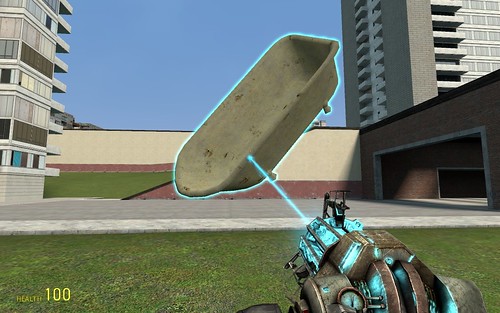
If you let go it drops to the floor, with a satisfying physics engine bounce and crash.
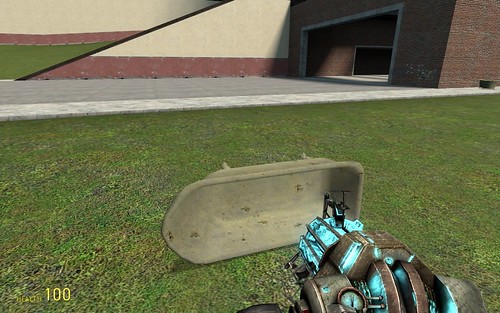
If you want to put a ragdoll physics scientist in the bath you can do that too.

It is these ragdolls that have an extra context menu on them. If you have a Kinect plugged into your windows machine, and have the right drivers (1.6) then you can then control these ragdoll avatars with your motions. Not only that but you can control more than one at the same time. Lots of scope here for animated dance sequences.
The first time it worked was a magical moment, it blended the initial memories I had of the engine, with the buzz of what we have today to experiment with.
The skeletons of the Source avatars do not seem to be the same resolution as the more detail kinect skeleton so this is not perfect for my Choi Kwang Do attempts to instrument the body, but… they do help try out the kinect. The rest of the things we can build, and that the predlets will build is going to be interesting.
Oh, there is also an amusing “minecraftify” option in Gmod that turns all the textures blocky. So worlds are merging.
I have yet to try using the 360 kinect on the Mac with its version of Gmod but there is certainly a lot of exploring to be done.
Happy Holidays 🙂
Veteran – Yes I do read books sometimes!
I have just go back from a great 2 weeks mostly off the net in Spain (well nearly!). Whilst I had the Mac with my it managed to stay pretty much closed and I focused on doing a few less techie things. The first of those was my regular Choi Kwang Do patterns which I spent quite a lot of time practicing in the hot sun by the pool at the villa. It was interestingly meditative as well as being physically beneficial despite it being a little out of context for a summer holiday.
The holiday though was not devoid of tech. With the ipad, kindle, 2 DSi XL and 1 3DS, plus a TV showing satellite channels including lots of re-runs of Star Trek original series and Voyager we were not totally unwired, just a local net. I finished Splinter Cell on the 3DS despite its initially annoying control mechanism.
This post is about something else though.
I only really get to read books, fictional based ones, on holiday. I should read more, but I don’t. Before we headed out I bought myself Veteran by Gavin Smith (in paperback as I don’t own the Kindle it is my wife’s)
I knew nothing about this except what I spotted on the sleeve, but it looked a good cyberpunk action book.
I have to say it was better than good, I even finished it before the end of the holiday.
For me it had everything I needed in a book of that nature. Armoured augmented human soldiers, social decay, post apocalyptic gangs, dangerous corporations. It also featured the hackers who access the net directly via a socket in their heads and then represented themselves in all sorts of interesting ways as they dealt with the odd experience of being jacked into the net.
There was a lot of shooting and fighting, a lot of rebuilding. So it had the action box ticked. However it actually wrestled with very interesting central issue. I am trying not to give any spoilers here BTW.
In a good versus bad with a confused 3rd party in the middle the notion of openness to information was being played out. one digital based information system, or weapon was being developed by the libertarian hackers. Throughout they spoke in open source terms, in a self determination that was working against the corporate, government and warring controllers. It didn’t preach though, it showed the though patterns the characters were taking, their various ideals and motivations clashing at times. However it also showed that they were not totally sure what the outcome of such openness would be, but that it had to be done.
I was not expecting such depth of though and reasoning to surface in the book as I was reading the comforting, almost stereotypical augmented soldiers fights. Replaced eyes for lenses (a la William Gibson), the net representation (a la Stephenson). However these were not so much stereotypes as clear genre requirements that were then used to take a further journey into the politics of freedom of information, over command and control structures. It was very thought provoking.
So much so I just went and bought the follow up book War in Heaven.
It also got me thinking about my own plot lines in this sort cyberpunk environment, in the days I did not have the book to read. Who knows they may express themselves somewhere too 🙂
Of course, if I had of been reading this on the Kindle on holiday I would have been able to just download and get on with it. Hmmm, maybe I do need one after all. Of course I would have to double that up with another holiday away from it all to make sure 🙂
Anyway, back to normal, whatever that is. Lots to do this month, several articles to write, some virtual world work to code and the (ever) ongoing search for the right funding for the ground breaking meta game project.
Olympic legacy, what next? Daley Thomson’s Decathalon 2?
So the first part of the Olympic experience is complete. Next up the paralympics. we were lucky enough to get some tickets in the fiasco that was the Visa only powered ticketing ballot/raffle and we went and saw the Gymnasts do their thing at the North Greenwich Arena (a.k.a. O2, a.k.a Millenium Dome).
It was really interesting to see the event as a whole.

We all hope of course that more people will get into sporting activity and generally keep the sociable atmosphere that we have all enjoyed at the friendly games as they have come to be known.
I have no doubt many kids will at least try and take up sport, and the government will apply the right funding and not let all schools sell off all their fields.
The predlets have been amazed by it all, Predlet 1.0 wants to continue her gymnastics, but it also now joining predlet 2.0 and I in Choi Kwang Do. So I suspect that will be mirrored across the country providing the clubs can cope with the demand.
It has also led ( in hour house) to some competitive gaming with the “official 2012 game” on the Xbox. Whilst it does have some flaws it is quite a collection of button bashing angle selecting frustration inducing game play, but it does make everyone have to accept whether they are faster, or better at that instant in time and it does reward practice.
We have of course been there before with sports games. The original arcade Track and Field was a masterpiece of gaming cabinet action.
This then managed to be sort of cloned 😉 and placed in our homes with the then new machines of the C64 and Spectrum with Daley Thompson’s Decathalon Using our GB hero as the lead character and something that is talked about much more fondly than the arcade game.
So will there be a new rash of TeamGB star games? Will that be part of the legacy? Being able to emulate one of the stars of the games will continue to inspire kids, some of whom will take up the sport because they also get to play it and understand a bit about it and get a thirst for winning not just levelling up for ever as many games seem to rely on now.
A more important legacy, and this is wishful thinking, is that the next games understands and embraces the way we choose to communicate online, not trying to stifle it or blame it for branding transgressions.
(I have to say for all the official branding fuss the actual event we went to seemed almost completely free of in your face advertising).
I also hope the next Olympics will take the sort of wonderful digital coverage the BBC provided, and still provides with archives and extends it to give us things we can interact with, 3d spatial data we can learn from and maybe even use in the games experiences I already mentioned. I noticed at the gynastics they had a matrix style camera on the vaulting horse. It was only used a few times in replays but it generated an image from the front and panned 90 degrees to the side filling in the gaps and looked brilliant. Imagine being able to choose to view that sort of replay in any event from any angle just as we can right now with multiplayer online game replays.
Yes I am still talking about the sort of thing we built in ’06 for Wimbledon in Second Life, years ahead of its time it would appear! but lets hope Rio brings a new look at the technology. Even if it is the simplest of e-commerce ticketing applications being done correctly !
So, I loved the Olympics, the team delivering the actual event, and the athletes efforts were brilliant. Well done to them. It was also astoundingly good for TeamGB 🙂 well done all.
